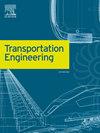基于驾驶员记忆和交通刺激的宏观交通表征
Q1 Engineering
引用次数: 0
摘要
提出了一种新的宏观交通流模型,该模型结合了过渡段的交通线形行为。在这个模型中,速度是车头时距和驾驶员反应时间的函数。它可用于表征均匀和非均匀车头时距的交通流。众所周知的张模型基于驾驶员记忆来描述这种流动,这可能会产生不切实际的结果。针对2000m环形道路上的非活动瓶颈,对所提出的Khan-Imran Gulliver(KIG)和Zhang模型的性能进行了评估。结果表明,KIG模型的交通行为更加真实。本文章由计算机程序翻译,如有差异,请以英文原文为准。
Macroscopic traffic characterization based on driver memory and traffic stimuli
A new macroscopic traffic flow model is proposed which incorporates traffic alignment behavior at transitions. In this model, velocity is a function of the distance headway and driver response time. It can be used to characterize the traffic flow for both uniform and non uniform headways. The well-known Zhang model characterizes this flow based on driver memory which can produce unrealistic results. The performance of the proposed Khan-Imran-Gulliver (KIG) and Zhang models is evaluated for an inactive bottleneck on a 2000 m circular road. The results obtained show that the traffic behavior with the KIG model is more realistic.
求助全文
通过发布文献求助,成功后即可免费获取论文全文。
去求助
来源期刊

Transportation Engineering
Engineering-Automotive Engineering
CiteScore
8.10
自引率
0.00%
发文量
46
审稿时长
90 days
 求助内容:
求助内容: 应助结果提醒方式:
应助结果提醒方式:


